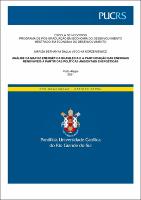| Share record |


|
Please use this identifier to cite or link to this item:
https://tede2.pucrs.br/tede2/handle/tede/9825| Document type: | Dissertação |
| Title: | Análise da matriz energética brasileira e a participação das energias renováveis a partir das políticas ambientais energéticas |
| Author: | Korzeniewicz, Mariza Bethanya Dalla Vecchia  |
| Advisor: | Souza, Osmar Tomaz de |
| Abstract (native): | O Brasil é reconhecido por ter sua matriz energética de consumo composta majoritariamente por fontes renováveis, sendo que somente a participação da energia hidráulica representa 63,5% do total de consumo. Contudo, a matriz energética de produção não apresenta a mesma composição de fontes de energias renováveis. Sabe-se, ainda, que a matriz brasileira foi moldada ao longo dos anos e as fontes de energias foram gradativamente alteradas. Assim, é importante diferenciar a matriz energética de produção e a matriz energética de consumo, uma vez que a primeira é majoritariamente composta por fontes de energia não renováveis, ao contrário da segunda, na qual mais da metade das fontes de energia são renováveis. Logo, para esta análise, são apresentados os dados de acordo com o Balanço Energético Nacional (BEN), disponibilizados pela Empresa de Pesquisa Energética (EPE). Além da apresentação e diferenciação da matriz, serão analisadas as fontes de energias segmentadas por renováveis e não renováveis, o que permitirá a discussão dos impactos ambientais causados pelas energias renováveis. Por fim, são apresentadas as políticas ambientais brasileiras adotadas ao longo dos anos, desde 1920, até as políticas mais atuais. |
| Abstract (english): | Brazil is known for having the energy consumption matrix composed mainly of renewable sources, with the participation of hydraulic energy alone representing 63.5% of total consumption. However, the production energy matrix is not composed of the same amount of sources of renewable energy. It is also known that the Brazilian matrix was shaped over the years and energy sources were gradually changed. Thus, it is important to differentiate the production energy matrix and the consumption energy matrix, since the first is mostly composed of non-renewable energy sources, unlike the second, in which more than half of the energy sources are renewable. Therefore, for this analysis, the data is presented according to the National Energy Balance (BEN), available by the Energy Research Company (EPE). In addition to the presentation and differentiation of the matrix, the energy sources are segmented by renewable and non-renewable, which will allow the discussion of the environmental impacts caused by renewable energies. Finally, the Brazilian environmental policies adopted over the years, from 1920, to the most current policies are presented. |
| Keywords: | Matriz Energética Políticas Ambientais Economia da Energia |
| CNPQ Knowledge Areas: | CIENCIAS SOCIAIS APLICADAS::ECONOMIA |
| Language: | por |
| Country: | Brasil |
| Publisher: | Pontifícia Universidade Católica do Rio Grande do Sul |
| Institution Acronym: | PUCRS |
| Department: | Escola de Negócios |
| Program: | Programa de Pós-Graduação em Economia do Desenvolvimento |
| Access type: | Acesso Aberto |
| Fulltext access restriction: | Trabalho não apresenta restrição para publicação |
| URI: | http://tede2.pucrs.br/tede2/handle/tede/9825 |
| Issue Date: | 31-May-2021 |
| Appears in Collections: | Programa de Pós-Graduação em Economia do Desenvolvimento |
Files in This Item:
| File | Description | Size | Format | |
|---|---|---|---|---|
| MARIZA _BETHANYA_DALLA_VECCHIA_KORZENIEWICZ_DIS.pdf | MARIZA_BETHANYA_DALLA_VECCHIA_KORZENIEWICZ_COMPLETO | 1.14 MB | Adobe PDF |  Download/Open Preview |
Items in DSpace are protected by copyright, with all rights reserved, unless otherwise indicated.




